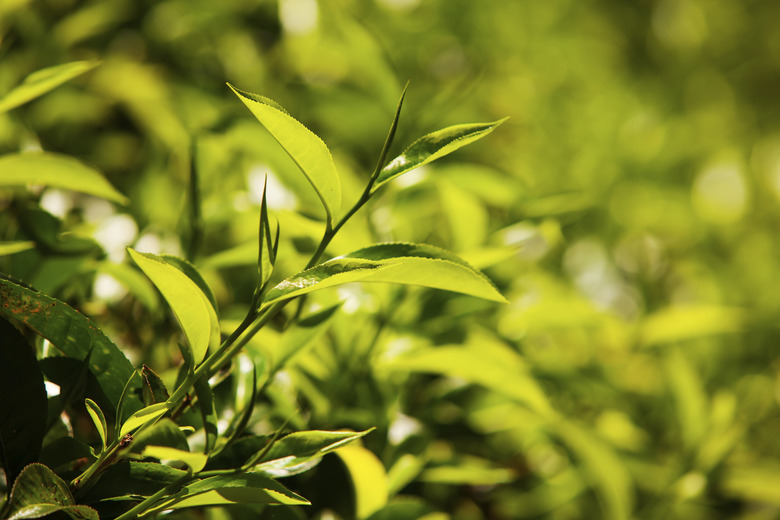How To Grow A Green Tea Plant
Attractive and useful, the tea plant (Camellia sinensis) is a broad-leaf shrub that boasts fragrant, delicate white blooms and shiny, evergreen leaves that can be harvested when young and processed to make tea. If you choose the right spot and provide the right care, you can grow a tea plant successfully in U.S. Department of Agriculture plant hardiness zones 7 through 9.
Lovely Location
Choose a site for your tea plant that has protection from direct afternoon sun and strong winds. A spot with partial shade or dappled sunlight with some protection from nearby tree canopies is ideal, although a tea plant should be kept 10 to 15 feet away from trees and structures. If you're planting multiple tea shrubs, space them 6 to 10 feet apart. Do not plant it in an area prone to flooding. A tea plant can grow up to 15 feet tall, so make sure you allow enough space for it. All pruning should be done in the spring after flowering.
- Attractive and useful, the tea plant (Camellia sinensis) is a broad-leaf shrub that boasts fragrant, delicate white blooms and shiny, evergreen leaves that can be harvested when young and processed to make tea.
Planting Prosperity
Select a healthy tea plant from the garden center that shows no signs of pests or diseases. Dig a large hole about 3 times the diameter of the root ball, planting the shrub at the same depth as it was in the container. After backfilling the hole with soil, water deeply to settle any air pockets. Tea plant prefers organically rich, fertile soil that drains well. Water frequently during dry periods to keep the soil moist, and mulch with 2 to 6 inches of organic material, such as bark or wood chips, keeping the mulch at least 8 inches from the shrub's trunk. To minimize fungal infections, water at the base of the plant to keep the leaves dry.
Nutrient Needs
A tea plant can benefit greatly from regular fertilizer applications. Every other month throughout the growing season, feed the shrub with a balanced 10-10-10 fertilizer. For every 10 square feet, thoroughly mix 1/3 ounce of liquid fertilizer with 1 gallon of water. Use a broadcast sprayer to the apply the fertilizer evenly to the soil, agitating it back and forth as you spray to keep the contents mixed. Avoid contact with your skin, and protect yourself by wearing long sleeves, pants and rubber gloves.
- Select a healthy tea plant from the garden center that shows no signs of pests or diseases.
- Use a broadcast sprayer to the apply the fertilizer evenly to the soil, agitating it back and forth as you spray to keep the contents mixed.
Pest Problems
A tea plant may have problems with aphids, mites and scale insects, all of which can hamper growth and damage the leaves. If a strong stream of water from the garden hose isn't enough to keep the pests at bay, consider applying horticultural oil. Mix 2 1/2 to 5 ounces of horticultural water in 1 gallon of water and apply evenly to the shrub's canopy using a pump or trigger sprayer. You may need to apply 3 or 4 gallons of the solution, depending on the size of the plant. Wear protective clothing, and keep the oil away from children and pets. If you get any of the solution on your skin, contact your physician.
